How to read a topographic map for hiking in Australia
I often meet hikers on the trail who seem confused about their location or direction of travel. I’ve also been involved in search and rescue operations where the groups we’ve found are not carrying any navigation aid. Most are not carrying a map and expect there will be an obvious trail or markers and signs to define the way. Or they may have had a map on their phone but the battery has died, making navigation a real challenge. Others I’ve met have a map but have confessed they don’t really know how to read it.
Knowing how to read a map isn’t difficult. All it takes is a bit of training, patience, practice and continual use. The symbols, topography lines and direction helpers on a map all require some understanding, but the answers are all right there.
Choosing the right map
A wide variety of maps are available for various purposes, each with its own symbols, legends, and scales. For hiking, you’ll need a topographic map, which shows the terrain, trails, and other features of the landscape.
Topographic maps are typically scaled at 1:25,000 or 1:50,000, meaning that one inch on the map corresponds to 25,000 or 50,000 inches in real life. This level of detail is essential for navigating trails and understanding the surrounding terrain.
Types of maps
- Road maps: These maps are designed for drivers and show highways, byways, and points of interest. They are not suitable for hiking as they lack the detail of topographic maps.
- Tourist maps: These maps are designed for sightseeing and show famous landmarks, attractions, and other points of interest. They may include some trail information, but they are not as detailed as topographic maps for hiking purposes.
- Sectionals: These maps are designed for pilots and show air routes, terminal areas, and landmarks. They are not suitable for hiking as they lack the detail of topographic maps.
- Online Maps: While online maps like Google Maps can provide a general overview of an area, they can be unreliable in remote areas or when internet access is limited. It’s important to have a physical map as a backup.
Printed Maps for Hiking in Australia: Several resources offer high-quality topographic maps for hiking in Australia:
- Outdoor Recreation Guides by SV Maps: These guides provide detailed maps, trail information, local flora and fauna information, local area history, and walk suggestions.
- Hema Maps: Hema Maps offers a wide range of topographic maps for Australia, including national parks, wilderness areas, and popular hiking trails.
- Gaia Maps: Gaia Maps is a digital mapping app that allows you to download and store topographic maps for offline use. It also includes features like GPS tracking, route planning, and elevation profiles.
Features of a hiking map
Maps are essential tools for hikers, providing valuable information about the terrain, trails, and landmarks in a particular area. To effectively utilise maps for hiking, it’s crucial to understand their basic elements and how to interpret them.
1. Map orientation
Most maps are oriented with north at the top, which is often indicated by a compass rose or a clear statement stating north as the top orientation. If there’s no specific indication, assume north is at the top. This standardised orientation helps you align the map with the actual landscape and determine directions accurately.
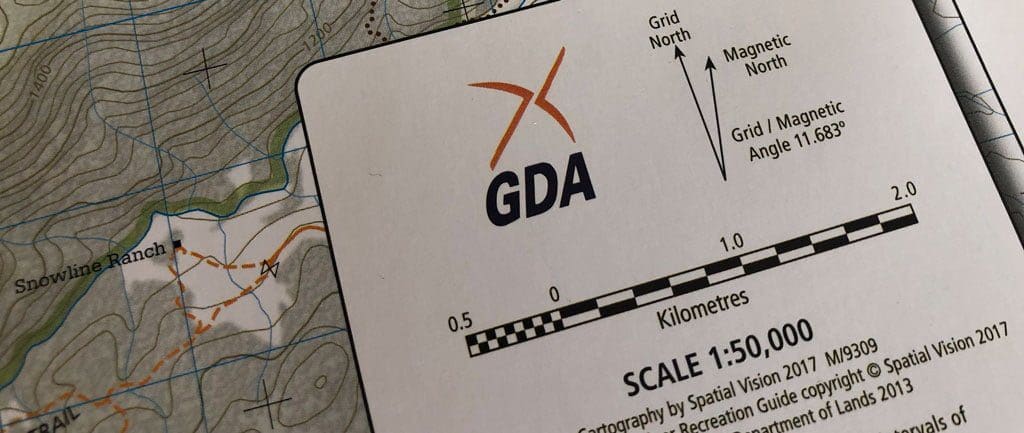
2. Map scale
The map scale represents the ratio between the map distance and the actual distance on the ground. It’s typically displayed on the side or bottom of the map and looks like 1:100,000. This means that one unit on the map corresponds to 100,000 units in real life. For hiking, a 1:50,000 or 1:25,000 map is generally recommended, providing detailed terrain representation. For driving, a 1:190,000 map is suitable, while for viewing large areas like entire countries, a 1:24,000,000 map is appropriate.
3. Grid lines and coordinates
Topographic maps often feature grid lines, which are horizontal and vertical lines running across the map. These lines intersect at points with grid coordinates, typically expressed as a combination of letters and numbers. Grid coordinates provide a precise way to pinpoint locations and communicate them to others.

4. Understanding latitude and longitude
Latitude and longitude are crucial navigational tools for hiking, especially in remote areas where landmarks may be scarce. Understanding these concepts will enable you to determine your precise location, plan your route effectively, and navigate safely.
1. Latitude: Latitude refers to the distance north or south of the equator, measured in degrees. The equator, an imaginary line dividing the Earth into Northern and Southern Hemispheres, is set at 0 degrees latitude. Locations north of the equator have positive latitude values, while those south have negative values.
2. Longitude: Longitude refers to the distance east or west of the Prime Meridian, an imaginary line running through Greenwich, England, also measured in degrees. The Prime Meridian is set at 0 degrees longitude, and locations east have positive longitude values, while those west have negative values.
3. Degrees, Minutes, and Seconds: Each degree of latitude and longitude is further divided into 60 minutes, and each minute is divided into 60 seconds. This allows for precise location identification. For example, a location with a latitude of 37°45’22″S and a longitude of 144°58’12″E would be located 37 degrees, 45 minutes, and 22 seconds south of the equator and 144 degrees, 58 minutes, and 12 seconds east of the Prime Meridian.
4. Grid Coordinates and Map References: Latitude and longitude coordinates are often used to identify specific locations on maps. These coordinates are typically expressed in a combination of letters and numbers, such as GDA94 (Geographic Datum of Australia 1994).
5. Latitude and Longitude on Maps: On topographic maps, latitude and longitude are usually indicated along the margins, with latitude values on the sides and longitude values on the top and bottom. These values allow you to pinpoint your location and orient the map correctly.
6. Practical Applications in Hiking: Latitude and longitude are particularly useful in hiking scenarios where landmarks or roads are absent. By knowing your latitude and longitude coordinates, you can:
- Determine your exact location: You can use online tools or GPS devices to convert your latitude and longitude coordinates to a specific address or location on a map.
- Communicate your location to others: If you need assistance or need to inform others of your whereabouts, providing your latitude and longitude coordinates will help them locate you precisely.
- Plan and follow routes: When planning your hiking route, you can use latitude and longitude coordinates to identify specific points of interest or trail junctions.
7. Remembering Latitude and Longitude: A simple way to remember which is latitude and which is longitude is to associate “latitude” with “lines of attitude,” as latitude lines run parallel to the equator, resembling lines of attitude. In contrast, “longitude” can be associated with “long lines,” as longitude lines run from pole to pole, resembling long lines.
Understanding latitude and longitude is essential for navigating safely and effectively in remote areas, especially during hiking excursions. By familiarising yourself with these concepts and using them effectively, you can enhance your hiking experience and ensure a safer and more enjoyable journey.
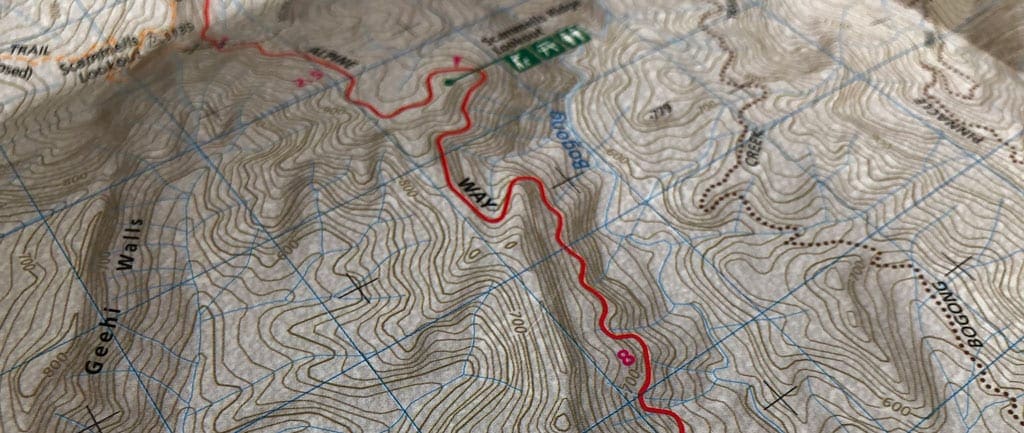
5. Understanding topographic contours
Topographic contours are a fundamental aspect of topographic maps, providing valuable information about the elevation and terrain of a landscape. By understanding and interpreting contour lines, hikers can effectively navigate trails, assess terrain challenges, and make informed decisions about their route.
What are Contour Lines? Contour lines are lines drawn on a map that connect points of equal elevation. They represent the height above sea level, providing a visual representation of the shape and slope of the land. The closer together the contour lines are, the steeper the slope, and the farther apart they are, the gentler the slope.
How to Read Contour Lines: To read contour lines effectively, follow these steps:
- Identify the contour interval: The contour interval is the difference in elevation between adjacent contour lines. It is typically indicated on the map legend or in a margin note.
- Visualise the terrain: Imagine the contour lines as horizontal slices through the landscape. The closer the contour lines are together, the more vertical space they represent, indicating a steeper slope.
- Determine elevation: The elevation of any point on the map can be estimated by identifying the nearest contour line. If you are between two contour lines, interpolate the elevation based on their spacing.
- Understand ridge and valley formation: Contour lines that form a “V” pointing uphill indicate a ridge or hilltop. Conversely, contour lines that form a “V” pointing downhill indicate a valley or depression.
- Recognise cliffs and rock outcrops: Abrupt changes in contour lines, where they suddenly become closer together or farther apart, often indicate cliffs, ravines, or rock outcrops.
Contour Lines in Hiking: Contour lines play a crucial role in hiking navigation and safety. By understanding contour lines, hikers can:
Assess trail difficulty: The spacing of contour lines can indicate the steepness of a trail, helping hikers choose routes that match their fitness level.
Identify potential hazards: Steep slopes, cliffs, and rock outcrops can be identified by analyzing contour patterns, allowing hikers to avoid potential hazards.
Plan for water sources: Streams and rivers often flow along valleys, which can be identified by contour lines forming a “V” pointing downhill.
Gain a sense of direction: By understanding the overall terrain shape and slope, hikers can better orient themselves and make informed decisions about their route.
Topographic contours are an essential tool for hikers, providing a detailed representation of the terrain and aiding in safe and effective navigation. By understanding how to read and interpret contour lines, hikers can enhance their hiking experience, minimise risks, and appreciate the diverse landscapes of Australia.

6. Understanding map symbols and legends
Maps are indispensable tools for hikers, providing a visual representation of the terrain, trails, and features of the landscape. A crucial aspect of map interpretation is understanding the symbols and legends used to represent these features.
What is a Map Legend? A map legend, also known as a key, is a graphic element on a map that explains the meaning of the symbols used throughout the map. It serves as a decoder ring, allowing hikers to interpret the visual language of the map and understand the features represented.
Types of Map Symbols: Map symbols are standardised visual representations of various features on the map. They are typically categorised into groups based on the type of feature they represent:
- Linear features: These symbols represent features that extend in a line, such as roads, trails, rivers, and streams.
- Area features: These symbols represent features that cover an area, such as forests, national parks, and urban areas.
- Point features: These symbols represent features that occupy a specific point on the map, such as towns, campsites, and landmarks.
Common Map Symbols for Hiking: Here’s a breakdown of common map symbols encountered in hiking maps:
- Roads: Roads are typically represented by lines of varying thickness and color, with wider and darker lines indicating major highways or roads.
- Trails: Hiking trails are often depicted by dashed lines, sometimes with color-coding to indicate different trail types or difficulty levels.
- Rivers and streams: Rivers and streams are typically represented by blue lines, with larger and darker lines indicating larger bodies of water.
- Forests: Forests and woodlands are usually depicted by a solid green fill or a pattern of green symbols, such as trees.
- Towns and cities: Towns and cities are often represented by pink or yellow polygons, with the size and boldness of the name indicating relative population size or importance.
- Buildings: Buildings are typically represented by gray or black rectangles or symbols, with larger and darker symbols indicating larger or more prominent structures.
Interpreting Map Legends: To effectively interpret map legends, follow these steps:
- Locate the legend: The legend is usually positioned in a corner or margin of the map.
- Identify symbol categories: Look for groups of symbols representing different types of features, such as linear, area, or point features.
- Match symbols to meanings: Carefully compare the symbols on the map to the corresponding symbols in the legend.
- Pay attention to color variations: Colors often convey additional information about features, such as road types or trail difficulty levels.
- Refer to the legend frequently: Use the legend as a reference throughout your map interpretation process.
Understanding map symbols and legends is essential for hikers to effectively navigate and interpret the information presented on topographic maps. By familiarising yourself with the standardised symbols and learning to decode the visual language of maps, you can enhance your hiking experience, make informed decisions about your route, and appreciate the diverse landscapes of Australia.

Finding your location using a map and compass
Navigating with a map and compass is a fundamental skill for hikers, providing a reliable method for determining your location even without electronic devices. This technique is particularly valuable in remote areas or when technology fails. By mastering this skill, you can enhance your safety and confidence while exploring the Australian wilderness.
1. Orient the Map: Before you begin, ensure your map is correctly oriented. Most maps have a compass rose or a clear indication of north at the top. Align the compass needle with the north arrow on the map to orient the map accurately.
2. Identify Landmarks: Select two or three prominent landmarks that are clearly visible in your surroundings and can be positively identified on the map. These landmarks can be mountains, valleys, rivers, roads, or any other distinguishable features.
3. Take Magnetic Bearings: Using a compass, take magnetic bearings of the identified landmarks. A magnetic bearing is the angle between the north arrow on your compass and the landmark. Record each bearing and its corresponding landmark.
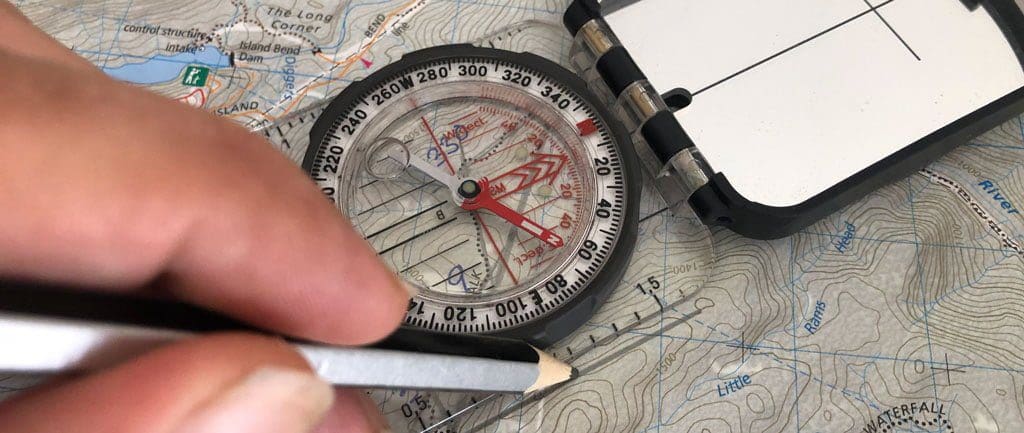
4. Convert Magnetic Bearings to Grid Bearings: Magnetic bearings need to be converted to grid bearings to accurately locate your position on the map. This is because magnetic north and true north do not always coincide. The difference between the two is called magnetic variation, typically displayed on the map legend. Add the magnetic variation value to each magnetic bearing to obtain the corresponding grid bearing.
5. Plot Grid Bearings on Map: Transfer the grid bearings you recorded onto your map. Draw lines from your starting point (where you are standing) towards each landmark, ensuring the angle of each line corresponds to the recorded grid bearing.
6. Triangulate Your Position: The intersection point of the three bearing lines on the map represents your approximate location. This point indicates the spot on the map that corresponds to your actual position in the landscape.

Additional Tips
- Choose landmarks that are clearly visible and identifiable on the map, ideally with a good spread between them.
- Use a compass with a declination adjustment to accurately account for magnetic variation.
- Take multiple bearings from different landmarks to increase accuracy and minimise error.
- Practice this technique in familiar areas before venturing into remote locations.
Knowing how to find your location using a map and compass is an essential skill for hikers, providing a dependable fallback method in case of electronic device failures or unexpected situations. By mastering this technique, you can navigate confidently and safely in the diverse landscapes of Australia.
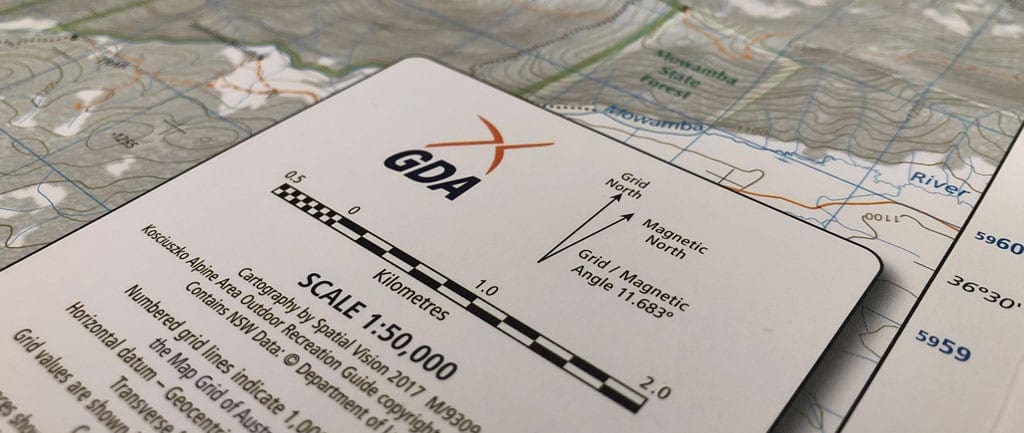
Understanding magnetic variation (Declination) when Hiking in Australia
When using both magnetic and grid bearings in Australia, it is important to understand the concept of declination and how to apply it correctly to ensure accurate navigation. Declination is the angle between magnetic north and grid north, and it varies depending on your location. In Australia, declination values can range from positive (east) to negative (west) and can change over time.
To accurately use both magnetic and grid bearings, you need to consider the grid magnetic angle (GMA), which is the angle between grid north and magnetic north at a specific location and time. The GMA is provided on most Australian topographic maps and is typically expressed in degrees east or west of grid north.
Magnetic Variation on Australian Maps: Every topographic 1:25,000 map in Australia shows the magnetic variation for that specific area. The magnetic variation is typically displayed in a legend or annotation on the map. It is important to note that the magnetic variation is slowly changing, so it is advisable to check the publication date of your map and adjust the value accordingly.
Converting magnetic bearings to grid bearings in Australia
Sometimes you will need to convert magnetic bearings, obtained from a compass, to grid bearings, which are used on maps. This conversion is necessary because magnetic north, the direction indicated by a compass needle, does not align perfectly with true north, the direction along a meridian line. The difference between magnetic north and true north is called magnetic declination.
In Australia, magnetic declination is constantly changing, and the rate of change varies across the country. To find the current magnetic declination for your location, you can use a magnetic declination calculator or consult a map legend. Magnetic declination values are typically expressed in degrees east or west of true north.
Another factor that affects the conversion between magnetic bearings and grid bearings is grid convergence. Grid convergence is the angle between the grid lines on a map and the true meridian lines at a particular location. Grid convergence is usually very small, and it can be positive or negative. The value of grid convergence is typically provided on map legends.
Steps to Convert a Magnetic Bearing to a Grid Bearing
- Obtain the magnetic bearing: Use a compass to take a bearing to the object of interest. This will be your magnetic bearing.
- Determine the magnetic variation: Look for the GMA (Grid Magnetic Angle) on your map. The GMA is typically expressed in degrees east or west. If you are in eastern Australia, add the GMA to the magnetic bearing to obtain the grid bearing. If you are in western Australia, subtract the GMA from the magnetic bearing to obtain the grid bearing.
- Adjust the compass: Rotate the compass dial so that the baseplate arrow is aligned with the grid bearing. Ignore the needle at this point.
- Orient the compass on the map: Place the compass on the map with the baseplate edge touching your current position. Rotate the entire compass until the north-south axis of the dial lines up with the vertical grid lines on the map.
- Read the bearing: The side of the compass now indicates the grid bearing to the object of interest. This is the direction you should follow on the map.
Alternative Method: An alternative method to converting magnetic bearings to grid bearings is to add the magnetic declination to the magnetic bearing at the time of taking the reading. This means aligning the compass dial with the north end of the compass needle at 12 degrees east (in eastern Australia) or 12 degrees west (in western Australia) rather than zero degrees.
Tip: The way I remember this in the east of Australia is that if I am adding the compass to the map (after taking a bearing), I need to add the magnetic declination to the magnetic bearing.
Converting grid bearings to magnetic bearings in Australia
Sometimes you will need to convert grid bearings, obtained from maps, to magnetic bearings, which are used for navigation with a compass. This conversion is necessary because magnetic north, the direction indicated by a compass needle, does not align perfectly with true north, the direction along a meridian line. The difference between magnetic north and true north is called magnetic declination.
In Australia, magnetic declination is constantly changing, and the rate of change varies across the country. To find the current magnetic declination for your location, you can use a magnetic declination calculator or consult a map legend. Magnetic declination values are typically expressed in degrees east or west of true north.
Another factor that affects the conversion between grid bearings and magnetic bearings is grid convergence. Grid convergence is the angle between the grid lines on a map and the true meridian lines at a particular location. Grid convergence is usually very small, and it can be positive or negative. The value of grid convergence is typically provided on map legends.
Steps to Convert a Grid Bearing to a Magnetic Bearing
- Obtain the grid bearing: Read the grid bearing from the map. This will be your grid bearing.
- Determine the magnetic variation: Look for the GMA (Grid Magnetic Angle) on your map. The GMA is typically expressed in degrees east or west. If you are in eastern Australia, subtract the GMA from the grid bearing to obtain the magnetic bearing. If you are in western Australia, add the GMA to the grid bearing to obtain the magnetic bearing.
- Adjust the compass: Rotate the compass dial so that the baseplate arrow is aligned with the magnetic bearing. Ignore the needle at this point.
- Orient the compass on the map: Place the compass on the map with the baseplate edge touching your current position. Rotate the entire compass until the north-south axis of the dial lines up with the vertical.
Tip: The way I remember this in the east of Australia is that if I am subtracting the compass from the map (after taking a bearing), I need to subtract the magnetic declination from the grid bearing.
Online Resources for Magnetic Variation
In addition to the magnetic variation information provided on maps, there are various online resources that offer updated magnetic variation data for specific locations. These resources can be helpful for obtaining the most accurate values for your hiking area. Understanding magnetic variation and knowing how to apply it when converting magnetic bearings to grid bearings is essential for accurate navigation using a map and compass. By factoring in magnetic variation, hikers can ensure they are plotting their routes correctly and navigating safely in the Australian landscape.
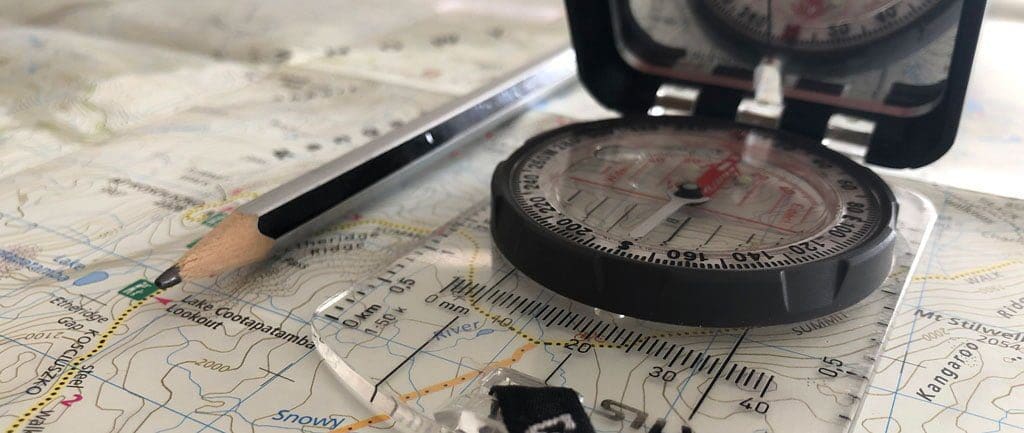
Navigating from point to point using a map and compass
Navigating from point to point using a map and compass is a fundamental skill for hikers, allowing them to plan their route and accurately follow it. By understanding how to take grid bearings and use a compass, hikers can confidently explore the Australian wilderness.
Taking a Grid Bearing
- Plot the Route: On your map, draw a line connecting your starting point (A) to your destination (B). This line represents your planned route.
- Align the Compass: Lay the edge of your compass along the line drawn on the map, ensuring the direction-of-travel arrow points towards your destination (B).
- Orient the Compass: Rotate the compass bezel until the north-orienting arrow on the bottom of the bezel aligns with the top of the map (grid north). This ensures the compass is aligned with the map’s grid system.
- Read the Grid Bearing: The grid bearing can now be read from the compass bezel along the index line. This bearing represents the direction you should travel to reach your destination.
Converting Grid Bearing to Magnetic Bearing
- Determine Magnetic Variation: Check the map legend or annotation for the magnetic variation value for your area. Magnetic variation is the difference between magnetic north and grid north.
- Apply Magnetic Variation Rule: Since you are physically subtracting the compass from the map to determine the direction of travel, you need to SUBTRACT the magnetic variation value from the grid bearing to obtain the magnetic bearing.
- Calculate Magnetic Bearing: Magnetic bearing = Grid bearing – Magnetic variation
Using a Compass for Navigation
- Set Magnetic Bearing: Rotate the compass bezel until the magnetic bearing you calculated aligns with the index line.
- Align Compass Needle: Hold the compass flat and rotate your body until the north end of the magnetic needle aligns with the north-orienting arrow on the bezel.
- Maintain Direction: Keep the compass flat and follow the direction of the compass needle, ensuring it remains aligned with the north-orienting arrow. This will guide you towards your destination.
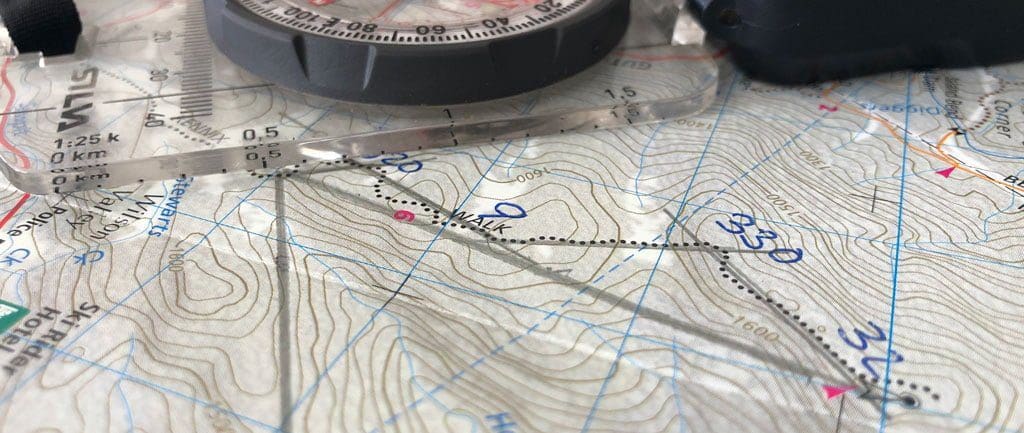
Tips for effective navigation
- Break Down Long Routes: Divide longer routes into shorter segments to avoid fatigue and maintain focus.
- Reassess Regularly: Check your map and compass periodically to ensure you remain on track.
- Adjust for Obstacles: Be prepared to adjust your route if you encounter obstacles, such as rivers or cliffs.
- Pay Attention to Surroundings: Observe the terrain and surrounding features to avoid hazards or unexpected changes in the landscape.
By understanding how to take grid bearings, convert them to magnetic bearings, and use a compass for navigation, hikers can effectively plan their routes and navigate safely in the Australian wilderness. These skills enhance hiking experiences, promote safety, and allow hikers to appreciate the diverse landscapes of Australia.
Find our more about how to use a compass here >>
















So do you print out maps from SV maps before hiking, or do you buy individual national park maps each time (for example)?
It’s now 2020 – has your regime changed?